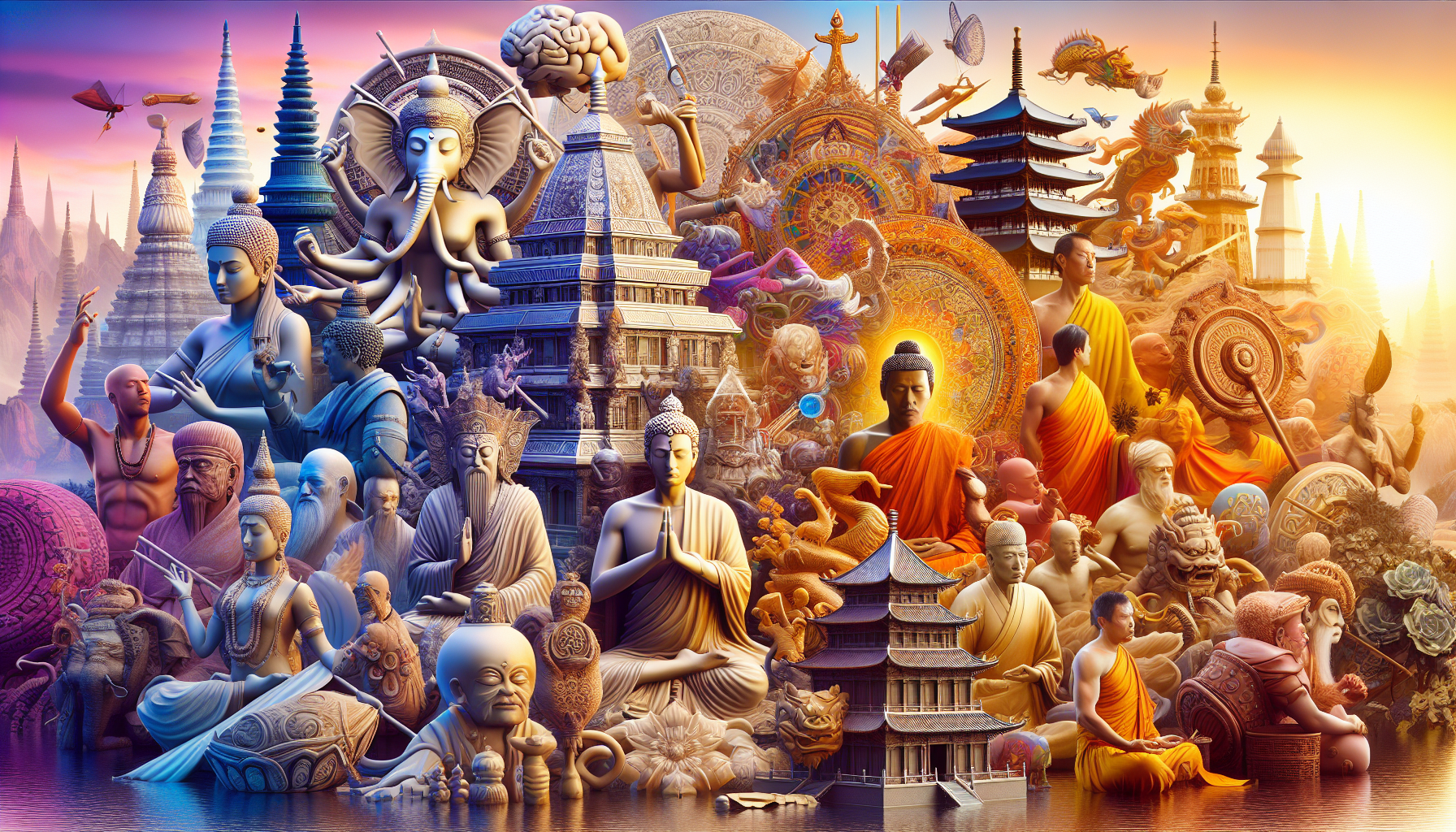Advertisements
Discover fascinating Asian religions such as Hinduism, Buddhism, Taoism and more in this comprehensive content. We will explore the origins, beliefs and practices of these ancient traditions that have a great influence on the culture and spirituality of the Asian continent.
Discover the fascinating Asian religions: Hinduism, Buddhism, Taoism and more
Hinduism
Hinduism is one of the oldest religions in the world, originating in India. With a variety of gods and goddesses, Hindus believe in reincarnation and karma. The practice of yoga and meditation are essential for followers of this religion, who seek union with the divine.
Buddhism
Buddhism originated in India and spread to several Asian countries, including China, Japan and Thailand. Buddhists follow the teachings of Buddha, who preached the middle path and the search for enlightenment. Meditation and compassion are central practices for Buddhists.
Advertisements
Taoism
Taoism is an ancient Chinese tradition that values harmony with nature and the balance between opposites, such as yin and yang. Taoists seek the Tao, the path that guides all things, through meditation, the practice of Tai Chi Chuan and Feng Shui.
- Hinduism
- Buddhism
- Taoism
Shintoism
Shintoism is the native religion of Japan, which venerates kami, nature spirits and ancestors. Shinto rituals are performed in temples and shrines, where Japanese people seek to purify their souls and obtain divine protection.
Sikhism
Sikhism originated in India and advocates equality among all people, regardless of their social or religious background. Sikhs follow the teachings of Guru Nanak and value meditation, charity, and social justice.
Jainism
Jainism is an ancient Indian tradition that values non-violence and material detachment. Jains follow the teachings of the Tirthankaras, enlightened beings who taught the path to spiritual liberation through meditation and renunciation.
Advertisements

Asia, as the birthplace of some of the world’s greatest religious traditions, offers a rich and multifaceted spiritual diversity. This diversity is not limited to the variety of beliefs, but also to the religious practices, rituals and philosophies that have shaped and continue to shape entire societies over the centuries. Understanding the religious differences present in the Asian continent is essential not only for personal and spiritual growth, but also for building bridges between cultures, fostering respect and empathy between peoples.
Buddhism, for example, originated in India and spread widely throughout Southeast Asia, China, Japan, and beyond. Its deep philosophical roots, which focus on the search for enlightenment and overcoming human suffering, continue to inspire millions of people around the world. In Japan, for example, Zen Buddhism emphasizes meditation and simplicity as means to achieving inner peace. In countries such as Thailand and Cambodia, Theravada Buddhism focuses on the path to enlightenment through moral action and meditation. These different forms of Buddhism exemplify the flexibility of Asian spirituality, where practices can be shaped by the specific needs and cultural contexts of each society.
In India, spirituality is deeply intertwined with everyday life, whether through Hinduism, one of the world’s oldest religions, or other traditions such as Sikhism and Jainism. Hinduism, with its vast array of gods, goddesses, and philosophies, provides a deep understanding of the nature of the universe and the self. The practice of rituals such as pujas (prayers) and festivals such as Diwali reflect an intimate connection with the divine and a constant search for harmony and balance in life. Jainism, with its emphasis on non-violence and the pursuit of spiritual purity, offers a unique perspective on life and the relationship with all living beings.
Islam also has a significant presence in Asia, particularly in the Middle East, Southeast Asia, and South Asia. Countries such as Indonesia, Pakistan, and Bangladesh have large Muslim populations, and Islam profoundly shapes the social, political, and cultural life of these countries. The practice of Islam, with its emphasis on prayer, fasting, charity, and pilgrimage, offers a spiritual path of surrender to God (Allah) and service to humanity. Asian Islam, with its regional variations, combines traditional practices with local diversity, creating a rich tapestry of religious expressions.
In addition to these major religions, Shamanism, Taoism, Confucianism, and Christianity also play important roles in various Asian cultures. Taoism, with its focus on harmony with nature and the balance of the universe, has been a fundamental influence in China, while Confucianism, although often considered more of a philosophy than a religion, has shaped the ethical and social principles of Chinese society and other East Asian countries. Shamanism, with its belief in interacting with nature spirits, is particularly strong in Mongolia and parts of Siberia, while Christianity, which has a long history in the Philippines and South Korea, continues to have a growing impact in several Asian nations.
As we explore these different religious traditions, we are invited to reflect on the similarities and differences between them. Although practices and rituals vary, many of these religions share a common quest: connection with the divine and the pursuit of spiritual and moral well-being. In a globalized world where interactions between cultures and religions are increasingly frequent, understanding Asian religions becomes essential not only for personal enrichment, but also for building a more tolerant and respectful world.
Understanding and respecting religious differences provides an opportunity to broaden our worldview and connect with others in deeper and more meaningful ways. In addition, these traditions teach us the importance of spirituality in our daily lives, whether it is experienced through meditation, service to others, or the pursuit of wisdom and self-knowledge. The spiritual journey in the Asian context is not only an individual quest, but also a collective journey, uniting people in a shared effort to achieve peace, harmony, and spiritual evolution.
Therefore, by exploring the religions of Asia, we are not only expanding our knowledge, but also cultivating empathy and understanding. This journey invites us to transcend cultural and religious barriers, strengthening the bonds of brotherhood and solidarity between peoples. Ultimately, by acknowledging the diversity of beliefs, we become more aware of our own spirituality and the role we play in the greater fabric of humanity. The journey of continued spiritual growth is an opportunity to enrich our connection with the divine and with others, fostering a more harmonious, compassionate and inclusive world.
Conclusion
In summary, Asian religions such as Hinduism, Buddhism, Taoism, Shintoism, Sikhism and Jainism represent an impressive cultural and spiritual richness. Each of these traditions has its own unique characteristics, beliefs and practices that reflect the diversity and complexity of spirituality in Asia. Through meditation, the search for enlightenment, the appreciation of nature and balance, these religions offer pathways to connection with the divine and personal growth.
Exploring and understanding Asian religions is an enriching opportunity to broaden one’s horizons and gain knowledge about different forms of spiritual expression. Through the practice of yoga, meditation, compassion and the pursuit of harmony, one can find inspiration and guidance for a more fulfilling and meaningful life.
Therefore, delving into the universe of Asian religions is a fascinating and transformative journey, which invites us to reflect on our own spirituality and seek a greater connection with the sacred. May we celebrate and respect the religious diversity of the Asian continent, recognizing the beauty and wisdom present in each of these ancient traditions.




